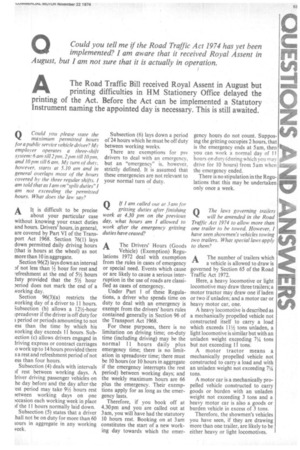Could you tell me if the Road Traffic Act 1974
Page 65

If you've noticed an error in this article please click here to report it so we can fix it.
has yet been implemented? I am aware that it received Royal Assent in August, but I am not sure that it is actually in operation.
The Road Traffic Bill received Royal Assent in August but printing difficulties in HM Stationery Office delayed the printing of the Act. Before the Act can be implemented a Statutory Instrument naming the appointed day is necessary. This is still awaited.
Q Could yOU please state the maximum permitted hours fora public service vehicle driver? My employer operates a three-shift system. 6am till 2 pm. 2 pm till 10 pm. and 10 pm tilló am. My turn of duty, however, starts at 5.10 am and in general overlaps most of the hours covered by the three regular NW' ts. I am told that as I am on"split duties" I am not exceeding the permitted hours. What does the law say?
A II is difficult to be precise about your particular case without knowing your exact duties and hours. Drivers' hours, in general, are covered by Part VI of the Transport Act 1968. Section 76(1) lays clown permitted daily driving hours (that is hours at the wheel) as not more than 10 in aggregate.
Section 96(2) lays down an interval )f not less than 1/2 hour for rest and -efreshment at the end of 51/2 hours iuty provided that the 51/2 hour )eriod does not mark the end of a ,vorking day.
Section 96(3)(a) restricts the vorking day of a driver to 11 hours. 3ubsection (b) allows a 121/2-hour ;preadover if the driver is off duty for period or periods amounting to not ess than the time by which his vorking day exceeds 11 hours. Sub;ection (c) allows drivers engaged in iriving express or contract carriages o work up to 14 hours provided there s a rest and refreshment period of not ess than four hours.
Subsection (4) deals with intervals )f rest between working days. A !river driving passenger vehicles on he day before and the day after the est period may take 91/2 hours rest )etween working days on one )ccasion each working week in place A* the 11 hours normally laid down. Subsection (5) states that a driver hall not be on duty for more than 60 lours in aggregate in any working veek. Subsection (6) lays down a period of 24 hours which he must be off duty between working weeks.
There are exemptions for ps), drivers to deal with an emergency. but an "emergency" is, however, strictly defined. It is assumed that these emergencies are not relevant to your normal turn of duty.
Q If I am called out at 3am for
gritting duties after finishing work at 4.30 pm on the previous day, what hours am I allowed to work after the emergency gritting duties have ceased? .
AThe Drivers' Hours (Goods Vehicle) (Exemption) Regulations 1972 deal with exemption from the rules in cases of emergency or special need. Events which cause or are likely to cause a serious interruption in the use of roads are classified as cases of emergency.
Under Part 1 of these Regulations, a driver who spends time on duty to deal with an emergency is exempt from the drivers' hours rules contained generally in Section 96 of the Transport Act 1968.
For these purposes, there is no limitation on driving time; on-duty time (including driving) may be the normal 11 hours daily plus emergency time; there is no limitation in spreadover time; there must be 10 hours (or 10 hours in aggregate if the emergency interrupts the rest period) between working days; and the weekly maximum hours are 66 plus the emergency. Their exemptions apply for as long as the emergency lasts.
Therefore, if you book off at 4.30 pm and you are called out at 3am, you will have had the statutory 10 hours rest. Booking on at 3am constitutes the start of a new working day towards which the emer gency hours do not count. Supposing the gritting occupies 2 hours, that is the emergency ends at 5am, then you can work a normal day of 11 hours on duty (during which you may drive for 10 hours) from Sam when the emergency ended.
There is no stipulation in the Regu lations that this may be undertaken only once a week.
QThe laws governing trailers will be amended in the Road Traffic Act 1974 to allow more than one trailer to be towed. However, I have seen showmen's vehicles towing two trailers. What special laws apply to them?
A The number of trailers which a vehicle is allowed to draw is governed by Section 65 of the Road Traffic Act 1972.
Here, a heavy locomotive or light locomotive may draw three trailers; a motor tractor may draw one if laden or two if unladen; and a motor car or heavy motor car, one.
A heavy locomotive is described as a mechanically propelled vehicle not constructed itself to carry a load which exceeds 111/2 tons unladen, a light locomotive is similar but with an unladen weight exceeding 71/4 tons but not exceeding 11 tons.
A motor tractor means a mechanically propelled vehicle not constructed to carry a load and with an unladen weight not exceeding 71/4 tons.
A motor car is a mechanically propelled vehicle constructed to carry goods or burden with an unladen weight not exceeding 3 tons and a heavy motor car is also a goods or burden vehicle in excess of 3 tons.
Therefore, the showmen's vehicles you have seen, if they are drawing more than one trailer, are likely to be either heavy or light locomotives.




















































































































